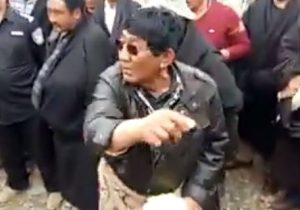
Tsewang Kyap
Photo: Screengrab
Tsewang Kyab, one of the Tibetan community leaders who led the protest against the Chinese government gold mining operation in Amchok Township in Sangchu county, eastern Tibet, died on April 25 following a prolonged illness.
In May and June 2016, over 300 Tibetans from eight villages in Amchok Township gathered to protest against the gold mining operation at the mountain of Nyenchen Gong-ngon Lari which they consider sacred and a divine protector over the centuries.
Kyab was one of the community leaders who were taken into police custody shortly after the protest and reportedly suffered internal organ damage due to police beatings and tortures. Though he was released shortly after his detention, locals believe that those injuries caused his illness which eventually led to his death.
In a video footage, Tibetan protestors were shown speaking to Chinese authorities, requesting them to stop the mining project. Kyab was seen passionately speaking in the video to “stop the destruction of the environment.” The villagers’ protests in May and June 2016 were brutally broken up by the Chinese military.

Protesters in Amchok carrying banners with slogan “Stop Mining at Amchok Gong Ngon Lari!”
Photo: TCHRD
The protests followed 16 years of frustration and repeated appeals to the authorities to stop the gold mining in Nyenchen Gong-ngonLari. Two Tibetans carried out self-immolation protests in November 2012 at the entrance to the gold mine –Tsering Dhondup, 35, set fire to himself on November 20, 2012, and Konchok Tsering, 18, did the same six days later.“Tsering wanted to highlight the hardship and suffering of the local Tibetans harmed by mining activities,” one friend said of him, describing him as a “gentle character,” devoted to both environmental issues and Tibet’s cause as a whole.
Tibet – also known as the roof of the world – is the highest and largest plateau in the world. Environmentalists say it sustains a unique but fragile high altitude eco-system that has remained unspoiled due to its remoteness. With China’s occupation of Tibet since 1959, exploitation of its natural resources to meet China’s economic growth has led to widespread environmental destruction in the form of damming, mining, deforestation and nuclear activities. These issues have become an ongoing cause of unrest among Tibetans.
The International Campaign for Tibet said that their Environmental Rights Initiative portrays the Tibetans’ right to be decision-makers over a range of issues critical to Tibet’s environment, including population resettlement, natural resource extraction, environmental stewardship, and sustainable development.




 Print
Print Email
Email